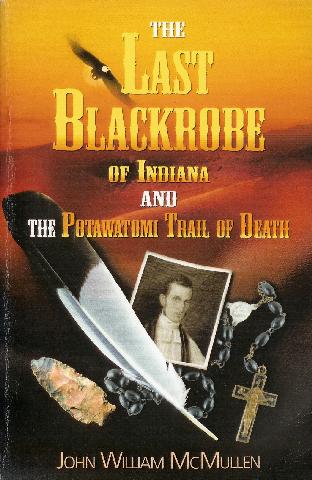 On a moonlit night, with the owl hooting, we heard the hoofbeats of a horse as he came galloping down the hill. He splashed through the creek, carrying Father Benjamin Petit, hastening on to comfort his people. Across Indiana he rode to catch up with the Mission Band of Potawatomi who were being forcibly removed to Kansas. At gunpoint they had marched down Rochester’s Main Street and through Logansport and Lafayette. This is a historical novel, with real people speaking as the author imagined them to speak. Chief Menominee, Abram Nanweshmah Burnett, Mas-saw and other Potawatomi discuss the treaties and how they feel about being bribed with whiskey to sign them. Benjamin Petit argues with his mother and his brother Paul about his decision to leave France to join Bishop Brute in the wild American frontier in Indiana. Governor Wallace and John Tipton exchange details of the plan to round up the Indians. William Polke and others converse about the problems they encounter on the emigration now called the Trail of Death. Day by day Polke must deal with the logistics of getting food for nearly 900 people, including Indians and wagon drivers and militia, and food for over 300 horses and oxen. Father Petit must perform mass and burial ceremonies and help the Indians face the deaths and daily hardships of the long trail. Many have read the Trail of Death letters of Father Petit and the diary kept by Polke’s secretary Jesse C. Douglas. But no one has written a book like this before. The author, John McMullen, is a high school teacher at Evansville and a professor at Ivy Tech Community College. He has written other historical novels and he is a terrific writer. He writes poetically and with fervor. He describes the people and conditions so that the reader feels he is actually there. He really did his research. Fellow historians will not find anything wrong. Maybe that is because he allowed Shirley Willard - Fulton County historian, and Susan Campbell - a member of the Citizen Potawatomi Nation, to proofread the book last summer. So any errors they found were corrected. Poetic license is taken but they are such that could have happened. For instance, there is no record of Father Petit coming back to Twin Lakes and arguing with General Tipton and Indiana Governor David Wallace. But if it had happened, this would have been the way it would have sounded. The spirit is there. Petit’s thoughts are very religious so part of this book reflects on religion and right and wrong, how the government betrayed the Indians and condoned slavery. Discussions on merits of liberal Catholicism vs. conservative, whether to allow the Mass to be said in Potawatomi or insist on Latin, and things non-Catholics seldom hear of. Most historians know that during the French Revolution, priests were beheaded, but few realize that the priests who came to establish missions in Indiana had lived through that period of history. Rochester and Chippeway, Fulton County’s first white village, are mentioned several times in the book, also the Manitou Monster. It documents the 61 day trek from Indiana through Illinois, Missouri and into Kansas. It is a fascinating read, and parts of it will bring tears to your eyes. The book has a soft cover with a color picture of Father Petit, an eagle, an arrowhead, a rosary and a quill pen. It has 423 pages plus vii pages introduction. An epilogue was written by Susan Campbell to tell what happened after the Trail of Death. McMullen, a Catholic, added a glossary of Catholic terms, an appendix with thumbnail sketches of several characters in the book, notes and bibliography. Shirley Willard wrote Appendix C, how the Trail of Death is being commemorated today. The book sells for $24 plus $6 shipping and handling. It is for sale at the Fulton County Historical Society, 37 E 375 N, Rochester IN 46975. To save shipping, get a copy at the museum gift shop, which is open Monday - Saturday from 9 a.m. to 5 p.m. |
| < Previous | Home | Next > |